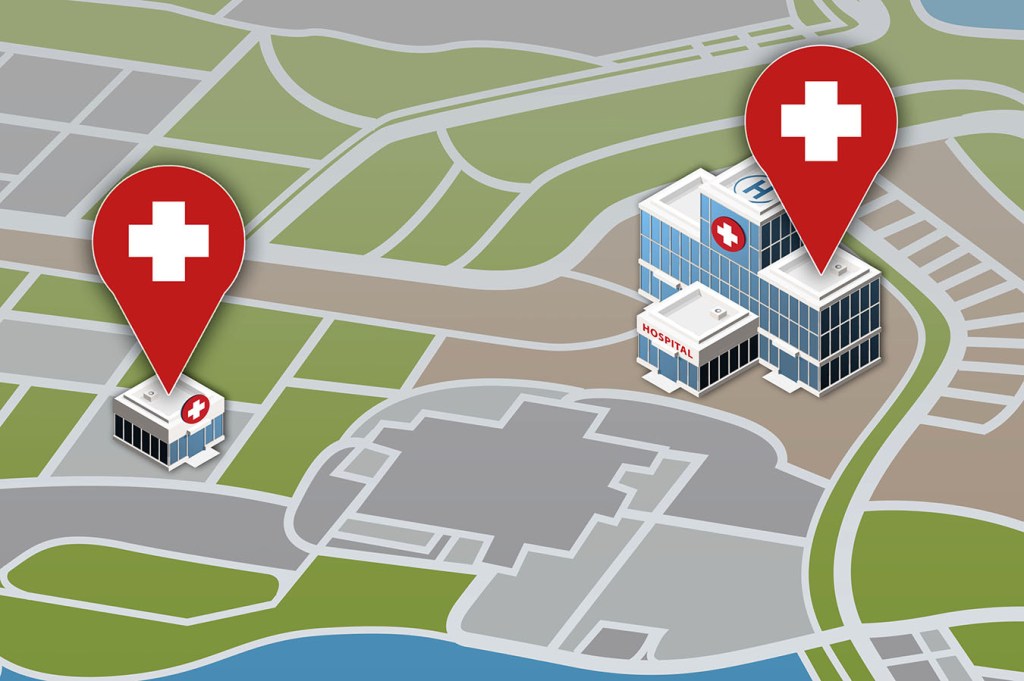The woman arrived at the emergency department gasping for air, her severe emphysema causing such shortness of breath that the physician who examined her put her on a ventilator immediately to help her breathe.
The patient lived across the street from the emergency department in suburban Denver, said Dr. David Friedenson, who cared for her that day a few years ago. The facility wasn’t physically located at a hospital but was affiliated with North Suburban Medical Center several miles away.
Free-standing emergency departments have been cropping up in recent years and now number more than 500, according to the Medicare Payment Advisory Commission (MedPAC), which reports to Congress. Often touted as more convenient, less crowded alternatives to hospitals, they often attract suburban walk-in patients with good insurance whose medical problems are less acute than those who visit an emergency room located in a hospital.
If a recent MedPAC proposal is adopted, however, some providers predict that these free-standing facilities could become scarcer. Propelling the effort are concerns that MedPAC’s payment for services at these facilities is higher than it should be since the patients who visit them are sometimes not as severely injured or ill as those at on-campus facilities.
The proposal would reduce Medicare payment rates by 30 percent for some services at hospital-affiliated free-standing emergency departments that are located within 6 miles of an on-campus hospital emergency department.
“There has been a growth in free-standing emergency departments in urban areas that does not seem to be addressing any particular access need for emergency care,” said James Mathews, executive director of MedPAC. The convenience of a neighborhood emergency department may even induce demand, he said, calling it an “if you build it, they will come” effect.
Emergency care is more expensive than a visit to a primary care doctor or urgent care center, in part because emergency departments have to be on standby 24/7, with expensive equipment and personnel ready to handle serious car accidents, gunshot wounds and other trauma cases. Even though free-standing emergency departments have lower standby costs than hospital-based facilities, they typically receive the same Medicare rate for emergency services. The Medicare “facility fee” payments, which include some ancillary lab and imaging services but not reimbursement to physicians, are designed to help defray hospitals’ overhead costs.
The proposal would affect only payments for Medicare beneficiaries. But private insurers often consider Medicare payment policies when setting their rules.
According to a MedPAC analysis of five markets — Charlotte, N.C.; Cincinnati; Dallas; Denver; and Jacksonville, Fla. — 75 percent of the free-standing facilities were located within 6 miles of a hospital with an emergency department. The average drive time to the nearest hospital was 10 minutes.
Overall, the number of outpatient emergency department visits by Medicare beneficiaries increased 13.6 percent per capita from 2010 to 2015, compared with a 3.5 percent growth in physician visits, according to MedPAC. (The reported data doesn’t distinguish between conventional and free-standing emergency facility visits.)
“I think [the MedPAC proposal] is a move in the right direction,” said Dr. Renee Hsia, a professor of emergency medicine and health policy at the University of California-San Francisco who has written about free-standing emergency departments. “We have to understand there are limited resources, and the fixed costs for stand-alone EDs are lower.”
Hospital representatives say the proposal could cause some free-standing emergency departments to close their doors.
“We are deeply concerned that MedPAC’s recommendation has the potential to reduce patient access to care, particularly in vulnerable communities, following a year in which hospital EDs responded to record-setting natural disasters and flu infections,” Joanna Hiatt Kim, vice president for payment policy at the American Hospital Association, said in a statement.
Independent free-standing emergency departments that are not affiliated with a hospital would not be affected by the MedPAC proposal. These facilities, which make up about a third of all free-standing emergency facilities, aren’t clinically integrated with a hospital and can’t participate in the Medicare program.
The MedPAC proposal will be included in the group’s report to Congress in June.
Even though stand-alone emergency facilities might not routinely treat patients with serious trauma, they can provide lifesaving care, proponents say.
Friedenson said that for his emphysema patient, avoiding the 15- to 20-minute drive to the main hospital made a critical difference.
“By stopping at our emergency department, I truly think her life was saved,” he said.







